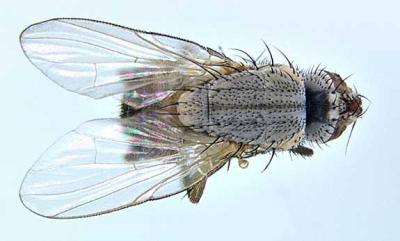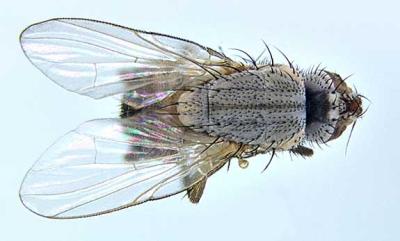


Sorghum shoot fly (Atherigona soccata)
It is the most important pest of sorghum at the seedling stage. The adult is similar to the housefly, smaller in size (3-5 mm long), and greyish in colour, and abdomen yellow with brown patches. The larvae or maggots are yellowish or whitish in colour, up to 8 mm long. The fly lays eggs either at the base of young shoots near soil surfaces, or in older plants, on the leaves. The maggots crawl inside the sheath and bore into the heart of the young shoot killing the growing point and the youngest leaf, which turns brown and withers. This damage is known as "dead heart". When good growing conditions prevail the young plants are usually able to compensate the damage by producing new tillers, which may partly escape attack, but later the ripening of the ear heads will be unequal. In weak plant repeated infestation may cause serious losses. Sometimes the damage is so severe that many seedlings die and the field has to be replanted. Older plants (over 30 days after seedling emergence) are generally not damaged by the shoot fly. However, when shoot flies are abundant (during the rainy season under moderate temperatures and high humidity) older plants may be attacked, but they do not produce the dead-heart symptoms. Instead, the damaged leaf becomes thin and papery, and wraps around the other leaves. As a result, the plants may fail to grow normally. Late infestations may also damage the panicle in the formative stage, resulting in rotting or drying up of a portion of the panicle affected by shoot fly damage.
- Conserve natural enemies. A range of natural enemies attacks the sorghum shoot fly: parasitic wasps attack eggs and maggots and predators cause high mortality of eggs. In particular, several species of spiders are important predators on eggs. For more information on Natural enemies click here
- Field sanitation. Crop residues should be collected and destroyed after harvest to reduce carry-over from one season to another.
- Plant resistant or tolerant varieties where available: Trials in Southern Africa has shown significant differences in resistance to shoot fly damage among varieties tested. Although the level of resistance in many of the sorghum varieties was low, several varieties with moderate levels of resistance were identified. Varieties "Pirira-1" and "Pirira-2" were the most resistant across seasons (van den Berg et al, 2005). In Eastern Africa, varieties "Serena" and "Seredo" showed high levels of recovery following shoot-fly damage (CABI; ICRISAT).
- Early sowing make often possible to have the period of vulnerability (seedling stage) over by the time the flies emerge.
- Uniform sowing of the same variety over large areas with the onset of rains reduces the damage by sorghum shoot fly.
- High seeding rates helps to maintain optimum plant stands and reduce shoot fly damage. There are reports that shoot-fly damage is higher when plant densities are low (CABI, 2000).
- Balanced fertiliser application. Application of fertiliser has been related to lower damage by shoot-fly possibly by increasing plant vigour. However, shoot-fly damage has been found to be greater in plots treated with cattle manure. This may have been due to the attraction of shoot flies to the odours emanating from the organic manure.
- Intercropping. It has been shown that shoot fly damage is reduced when sorghum is intercropped with leguminous crops.
- Fallowing and a closed season reduce the carryover and build-up of the shoot fly from one season to the next. These practices have been successfully used to reduce shoot-fly damage at ICRISAT. However, they may not practical for small-scale growers due to the shortage of land.
